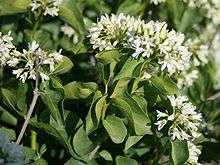Cionura
| Cionura | |
|---|---|
 | |
| Cionura erecta | |
| Scientific classification | |
| Kingdom: | Plantae |
| (unranked): | Angiosperms |
| (unranked): | Eudicots |
| (unranked): | Asterids |
| Order: | Gentianales |
| Family: | Apocynaceae |
| Subfamily: | Asclepiadoideae |
| Tribe: | Marsdenieae |
| Genus: | Cionura Griseb. |
| Species: | C. erecta |
| Binomial name | |
| Cionura erecta (L.) Griseb. | |
| Synonyms[1] | |
| |
Cionura is a genus of perennial plants found through the Mediterranean regions, the South and Eastern parts of the Balkan peninsula and Asia Minor to Afghanistan. It contains only one known species, Cionura erecta.[1]
The plants are woody stems, either upright or twinning with numerous herbaceous sprawling stems and poisonous milky sap. Bright-green broadly ovate leaves 7–12 cm long and 4–8 cm wide. Large clusters of delicate fragrant white flowers borne terminally from April to June. The plants bare fruits 8 cm long, with papery flap. Seeds have wide marginal wing all around with a terminal tuff of long white silky hairs. Because it is a poisonous plant, goats and sheep do not approach it.[2]
References
This article is issued from
Wikipedia.
The text is licensed under Creative Commons - Attribution - Sharealike.
Additional terms may apply for the media files.